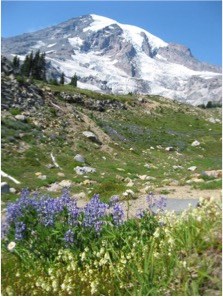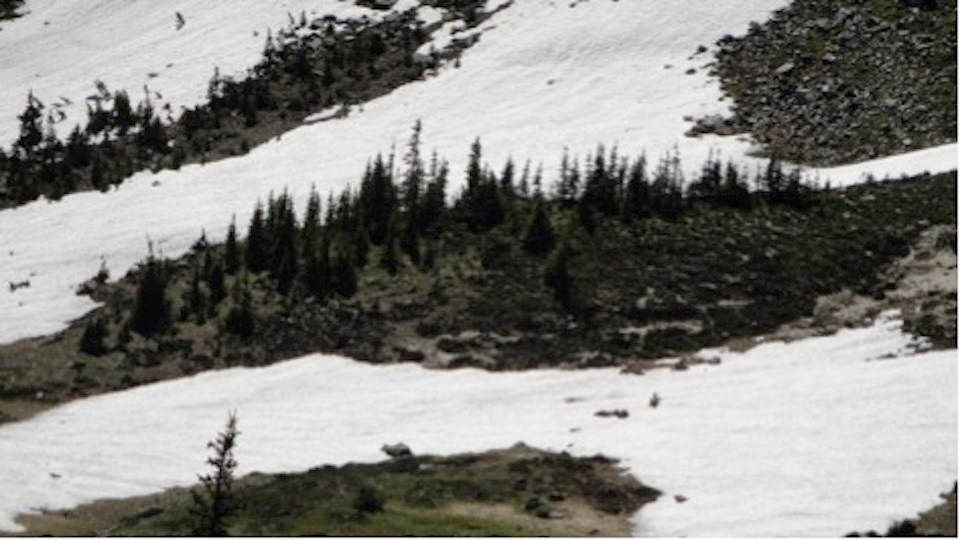Last updated: April 21, 2023
Article
Predicting the effects of future climate change on the subalpine and alpine meadows of Pacific Northwest Mountains

Importance
The subalpine and alpine meadows of Mount Rainier National Park (Figure 1) form a diverse and ecologically important component of the Park’s flora, and protecting these plant communities is important for maintaining biodiversity within the Park. For example, these meadows support seven of the 12 imperiled or rare plants in the Park (including the two plant species endemic to Mount Rainier and the local area). These meadows also provide important habitat for wildlife such as mountain goats, white-tailed ptarmigans, hoary marmots and the American pika. In addition, the meadows are a popular destination in the Park, with about 65% of visitors travelling to the meadows to view the wildflower displays. The Paradise Jackson Visitor Center (the Park’s main visitor center) and the Sunrise Visitor Center (the highest point in the Park that can be reached by car) are both situated on the edge of these meadows.
Subalpine and alpine meadows are found at high elevations where temperatures are too cold or snow covers the ground for too long for trees to grow. They occur between about 1650 and 2000 meters on the west side of the Park, and 1900 and 2200 meters on the east side. At lower elevations, trees outcompete meadow species. At higher elevations, conditions are not suitable for any plants to cover a large fraction of the ground, and only a few plants are able to establish in sheltered microhabitats. Meadows are probably found at lower elevations on the west compared to the east side of the Park because the west receives more snowfall, which shortens the snow-free period of the year in which plants can grow. Small-scale topographic features can also be important in determining the distribution of these meadows. For example, in the subalpine zone of the Park, meadows are typically found in depressions in the landscape (where large amounts of snow accumulate and snow-free periods are short), while patches of forest occupy ridges only meters away where relatively little snow accumulates and snow-free periods are longer.
Status and trend
Mount Rainier’s subalpine and alpine meadows are dynamic ecosystems. Trees, mostly subalpine fir (Abies lasiocarpa), have readily invaded the subalpine meadows of the Park over the course of the 20th century in association with warmer temperatures. These tree invasions have also been documented in a variety of other locations throughout the world. In addition, meadow plant species are able to colonize new habitat that was previously covered by ice or bare ground under favorable climatic conditions. Thus, rising temperatures in the 21st century could cause the total geographic range of these meadows to shrink, expand or remain the same, depending on the relative rates at which meadow species colonize bare land and trees invade meadows.
However, a general upward movement of the meadows will likely reduce the area of land they occupy because there is less land at higher elevations due to the conical shape of mountains. And although meadows occupying the flanks of Mount Rainier have high elevation land available to potentially colonize, meadows in the Park that occupy the peaks of smaller mountains will have no “escape route.” Furthermore, forests might move into meadows faster than meadowsexpand onto bare ground because tree seeds can disperse farther due to their greater seed release heights and because the poorly developed soils above the meadows may limit establishment (while trees would not face this constraint when establishing in meadows). This difference in migration rates between trees and meadow plants could also lead to meadows shrinking.
Thus, the objectives of this ongoing research are to: 1) use broad-scale climate models and fine-scale measurements of climate (using microclimate sensors) to assess where the climate suitable for meadows will be located in the future given climate change; 2) quantify dispersal limitations on tree and meadow plant migration by monitoring the distance that seeds are moved from parent plants; and 3) quantify establishment limitations on tree and meadow plant migration by comparing the performance of seedlings transplanted in fertile versus infertile soils at Mount Rainier.

Discussion
Initial results from broad-scale modeling suggest that date of snow disappearance is important for limiting the range of subalpine and alpine meadows at Mount Rainier (more so than temperature or precipitation per se) and that changes in climate predicted for the coming decades will result in an upward shift of the climate that has historically supported subalpine and alpine meadows. However, data collected from microclimate sensors show that snow disappearance date (and other climate variables) can vary dramatically over short distances due to differences in topography. In fact, snow disappearance date was, on average, three weeks later in topographic depressions than on ridges only 20 meters away, which was approximately equal to the average difference in snow disappearance date between locations near the upper and lower limits of the meadows (which are 200-300 meters apart in elevation). Thus, these topographic depressions are microhabitats that experience much later snow disappearance dates than the surrounding landscape and could provide important refugia for plant species that depend on long-lasting snowpacks as climate change progresses and snowpacks disappear earlier in the year. Preliminary results from vegetation surveys and seedling transplant experiments suggest that this fine-scale variation in snow disappearance date is important for plant distributions (Figure 2) and seedling establishment, but that the relationships are complex. Further research should help illuminate patterns in climate and how they affect plant species in the subalpine and alpine meadows of Mount Rainier.
